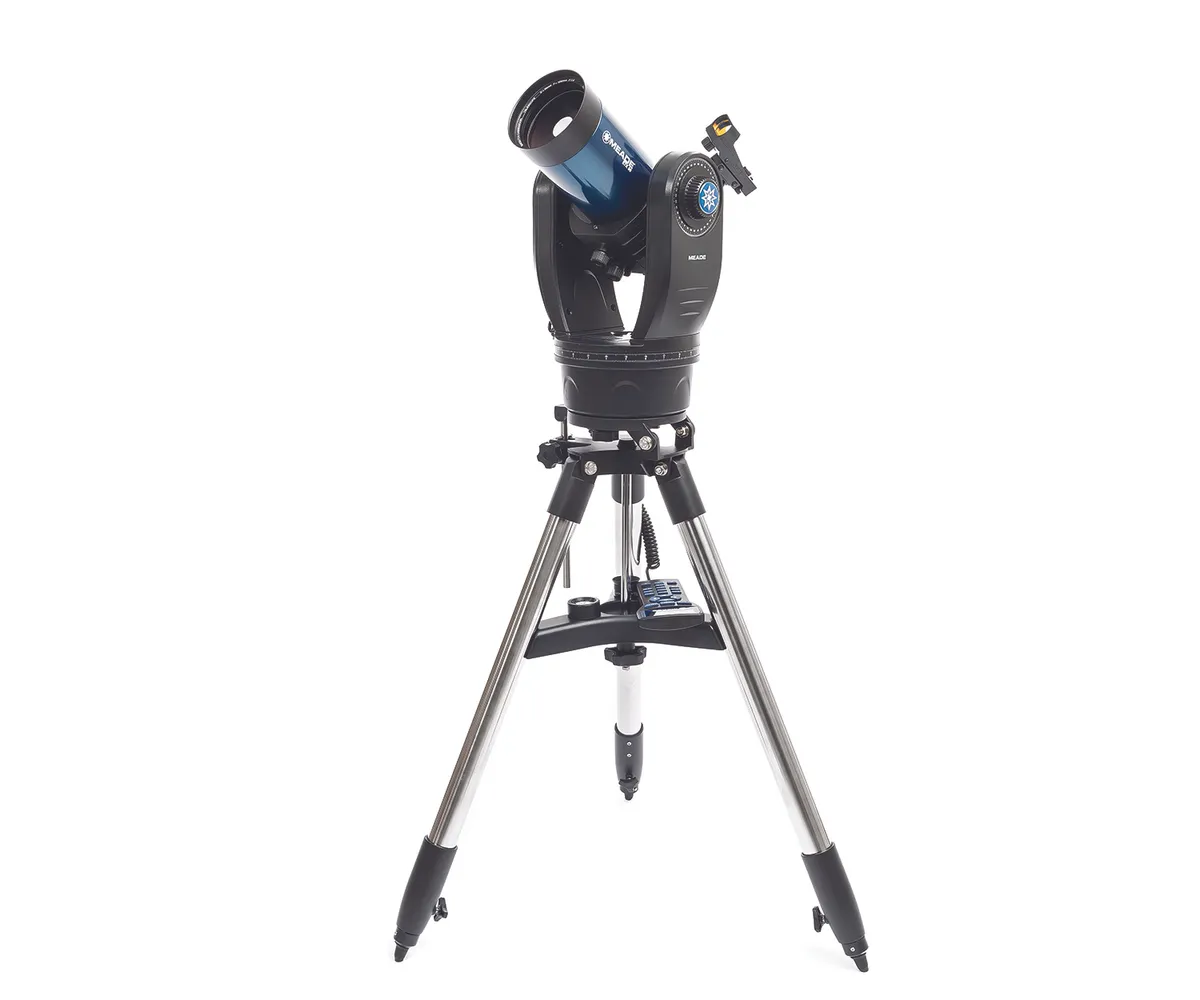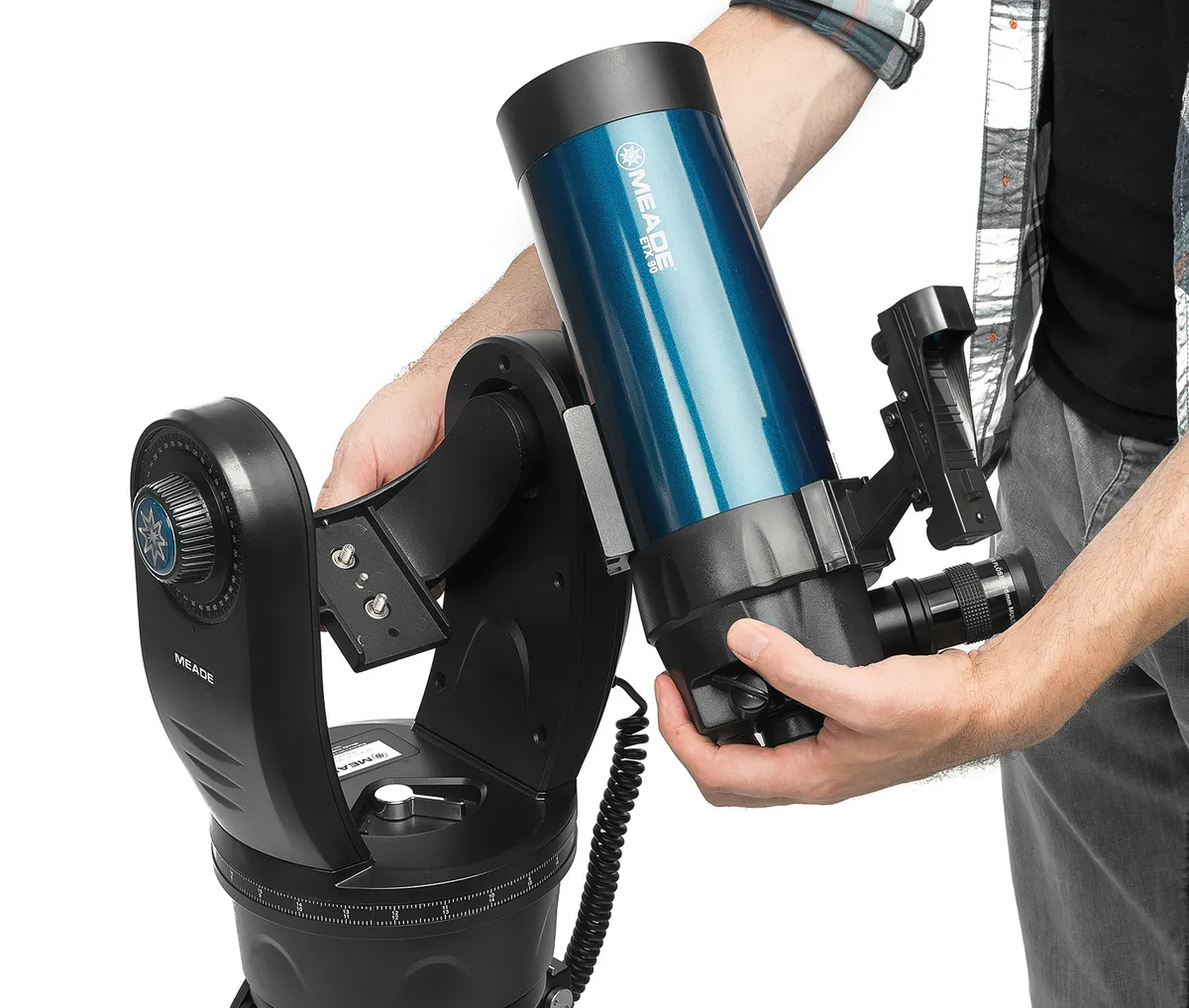The Meade ETX 90 Observer is the latest in a long line for this model – Meade has been producing the ETX 90 for well over two decades. This revamped version has new features added for the relaunch.
It is a 3.5-inch f/13.8 Maksutov-Cassegrain telescope tube atop a computerised dual-arm fork mount and a sturdy steel tripod.
It is supplied with an AudioStar controller that has a built-in speaker: as well as the 30,000 objects in its database, there are four hours of audio describing astronomical objects.
Also included are 26mm and 9.7mm 1.25-inch eyepieces, a red-dot finder, a hard carry case and a soft case for the tripod.
Assembly was easy and required no tools, ideal for a quick set up and go system.
Add the finder and an eyepiece along with connecting the hand controller and you are almost set.
Power is supplied by six AA batteries, which are not included. The battery compartment is set in the mount near the locking lever for the azimuth motion.
Power can also be provided by a 9-12V powertank, but you will need to purchase the Meade compatible cigarette cable to plug into the ETX mount.
On starting up for the first time the AudioStar controller requires the usual basic information – your location and if daylight savings time is in operation.It then gets the time and date and you are almost ready to begin.
For the Go-To to work in altaz mode, Meade offers two methods for initial start-up: true north or magnetic north.

Once we had levelled the tripod and telescope tube using the supplied magnetic compass/bubble level, we found that both options produced good results after we had performed an alignment procedure.
There are three ways to align – easy, one star and two star.
The tripod mounting plate can also be tilted to turn the mount into an equatorial system.
This allows you to track the stars for basic astrophotography or use the scope for prolonged observing sessions without having to endure the field rotation that occurs in altaz mode.
We used both modes for our tests, though bear in mind you need to also set the hand controller to altaz or equatorial mode for the Go-To to work properly.
On tour with an audio guide
We took the ‘tour’ option and enjoyed hearing interesting facts about the most popular targets.
The optics have ultra-high transmission coatings and the scope has a focal length of 1,250mm, giving magnifications of 48x and 129x with the supplied 26mm and 9.7mm eyepieces respectively. We felt the latter was close to the limit of usefulness.
The long focal ratio of f/13.8 is good for bright subjects such as the Moon and brighter planets, but unfortunately none of them was in a suitable position for viewing on the limited number of clear nights we had.
However, we did view Uranus and Neptune, with the first a lovely greenish-blue disc and the second a distinct bluish colour, making it stand out well.
The Go-To placed them close to the centre of the view, which helped confirm their identity.
We turned to the deep sky and were pleased that we could see many of the bright Messier objects despite the long focal ratio.
These included planetary nebulae M27 and M57, star clusters M11 and M34 and the magnificent Andromeda Galaxy, M31.
The latter did fill the view, but using the controller’s movement keys we could trace out the disc and even got a hint of a dust lane and the two companion galaxies, M32 and M110.
We did notice a little vignetting on the bottom half of the view when using the 26mm eyepiece; this turned out to be the flip mirror system, which didn’t quite tilt all the way back, but the effect was not too obtrusive and did not affect the 9.7mm eyepiece.

Using the flip switch at the rear of the telescope tube, you can direct the light away from the eyepiece to the camera port; note you will need a suitable T-adaptor to connect your own camera.
The mount is suitable for simple astrophotography of the Moon and brighter planets but not ideal for deep-sky imaging.
This is an enjoyable beginner system that will give you a lot of fun exploring the night sky with the benefit of audiotours.
Detachable tube
Meade has made the latest version extra versatile by allowing the telescope tube to detach from the dual-arm fork mount.
The mount is no longer directly attached to the telescope as a fixed unit, but instead there is a special carriage held between the forks that the tube sits in.
Once removed the tube can be attached to a different tripod – that could be a photo tripod, for example, if you wished to use the scope for simple observing without Go-To
or as a daytime spotting scope.
The tube attachment ‘foot’ doubles as a short Vixen-style bar, meaning it can be mounted on a different tracking mount too – useful if you have a dedicated equatorial mount for long exposure astrophotography.
We tried this out by attaching the tube to our own NEQ6 mount and took a series of images of globular cluster M2 in Aquarius and open cluster M103 in Cassiopeia, obtaining satisfying results.

Flip mirror and rear optical port
The ETX 90 has an easy, smooth to use focusing knob. It also possesses a flip switch that can allow you to either direct the light path up at a right angle to the eyepiece holder or to a port on the rear where you can attach a camera using a T-adaptor.
Optics
The telescope has a 3.5-inch aperture and a focal length of 1,250mm giving a focal ratio of f/13.8. It gave good views with pin-sharp stars out to 90 per cent of the field of view using the supplied 26mm eyepiece, with only minor distortion towards the edge.
Audiostar hand controller
The AudioStar controller has a database of 30,000 objects including Messier, NGC and Caldwell catalogues, planets, named stars, double stars and variable stars. It also features a built-in speaker and audio descriptions of 500 objects.
Tripod
The stainless steel tripod is sturdy and can easily hold the weight of the mount and telescope tube. It can be adjusted for height and features a tilting platform to make the system equatorial instead of altaz. There is also a useful eyepiece spreader tray.
Dual-arm fork mount
The dual-arm fork mount is sturdy and easily attached to the tripod via two bolts. There are ports for the hand controller, power from an external power tank, an on/off switch and an aux port. The mount also houses a battery compartment that takes six AA batteries.
Vital stats
- Price £469
- Optics Maksutov-Cassegrain
- Aperture 90mm (3.5 inches)
- Focal length 1,250mm (f/13.8)
- Mount Computerised dual-arm fork altazimuth
- Tripod Adjustable steel tripod with equatorial tilt plate
- Handset AudioStar hand control, 30,000-plus object database, integrated speaker
- Power Requirement Six AA Batteries or 9-12V DC power tank
- Extras 26mm and 9.7mm 1.25-inch eyepieces, red-dot finder
- Weight 8.6kg
- Supplier Opticstar
- Tel 0161 969 9008
- www.opticstar.com
This review originally appeared in the November 2016 issue of BBC Sky at Night Magazine.
